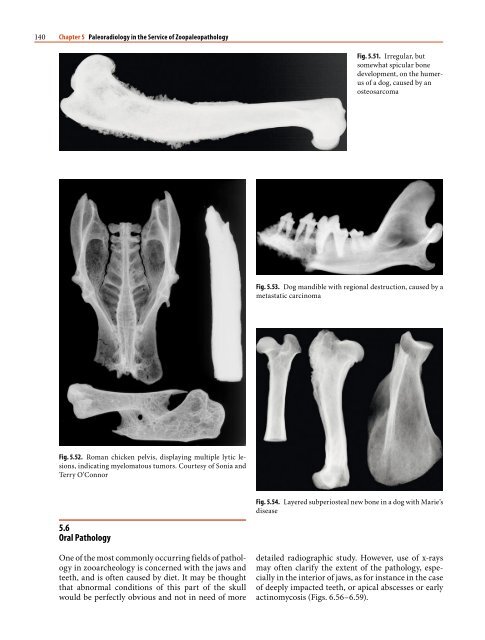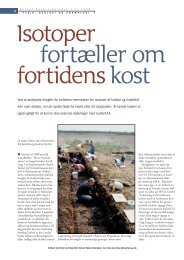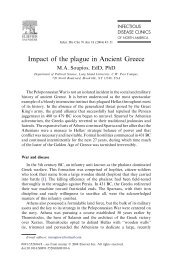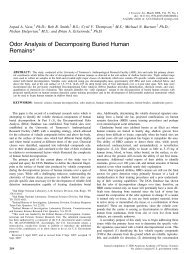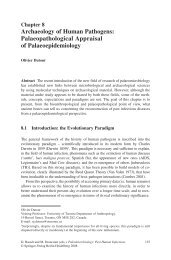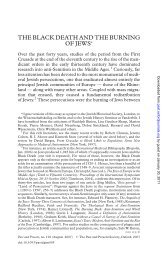1 Paleoradiology: History and New Developments - Academia.dk
1 Paleoradiology: History and New Developments - Academia.dk
1 Paleoradiology: History and New Developments - Academia.dk
You also want an ePaper? Increase the reach of your titles
YUMPU automatically turns print PDFs into web optimized ePapers that Google loves.
Fig. 3.18. X-rays of immature pig (left) <strong>and</strong> sheep jaws (right),<br />
showing variable internal age-related detail of tooth development<br />
of a similar kind on other mammals. As it is easier<br />
to x-ray living populations of domesticates, it is to<br />
be hoped that studies will eventually be initiated on<br />
possible age-related change, as mentioned previously.<br />
We also need growth information on wild species, as<br />
exemplified by a comparison of a neonate cave bear,<br />
with the x-ray of a neonate brown bear (Abel <strong>and</strong> Kyrle<br />
1931) (Fig. 3.19).<br />
One might hope that in the future, the interests of<br />
the zooarcheologist are combined with the biologist<br />
in order that research designs may include questions<br />
perhaps of special relevance to investigating past populations.<br />
Having said that, the radiographic study<br />
of skeletal growth provided by Whenham, Adam,<br />
<strong>and</strong> Moir (Wenham et al. 1986) on development in<br />
fetal red deer provides precise data of the kind that<br />
we need more of in archeology. Mention of this study<br />
serves to emphasize this continual need to relate<br />
modern data to the resolution of problems in the past,<br />
<strong>and</strong> indeed, there are now studies on a growing range<br />
of species, from Rhesus monkeys to horses <strong>and</strong> cattle<br />
(Brown et al. 1960; MacCallum et al. 1978; van Wagenen<br />
<strong>and</strong> Asling 1958; Wenham et al. 1969, 1986).<br />
With this kind of information for reference, ancient<br />
material can be aged more accurately (Kratochvil et<br />
al. 1988). It might also be noted here that studies on living<br />
species may have relevance to the interpretation<br />
of abnormal growth in the past (Rudali 1968).<br />
3.8 Frozen, Dried, <strong>and</strong> Mummified Bodies<br />
Fig. 3.19. Neonate cave-bear bones (right) compared with the xray<br />
of a modern neonate brown bear (left; after Abel <strong>and</strong> Kyrle<br />
1931.)<br />
A final point regarding growth is that it is clearly<br />
related to the degree of sexual dimorphism. Part of<br />
the final growth differentials leading to sexual dimorphism<br />
in parts of the skeleton may in fact result<br />
in changes to the internal architecture of bones, <strong>and</strong><br />
this matter has yet to be assessed.<br />
3.8<br />
Frozen, Dried, <strong>and</strong> Mummified Bodies<br />
For well over two centuries the arid conditions of<br />
Egypt, Peru, <strong>and</strong> other regions of the world have<br />
produced bodies of interest to archeology. Somewhat<br />
unusually, even part of the second woolly rhinoceros<br />
found frozen at Starunia in Pol<strong>and</strong> was x-rayed<br />
for detail of the foot (Fig. 3.20) (Novak et al. 1930).<br />
Some of the bodies, representing humans <strong>and</strong> other<br />
vertebrate species, have naturally dried after burial.<br />
Others, especially many from Egypt, have been submitted<br />
to mummification procedures – usually by the<br />
application of natron. After removing various inner<br />
organs <strong>and</strong> embalming all the soft tissues, the Ancient<br />
Egyptians wrapped the bodies of kings, queens,<br />
<strong>and</strong> special dignitaries, as well as a variety of ritual<br />
animals (cats, birds, shrews, even baby crocodiles <strong>and</strong><br />
snakes).<br />
63


